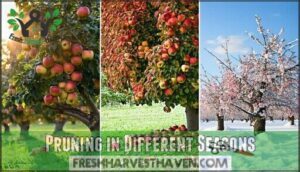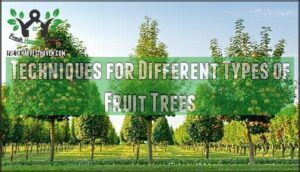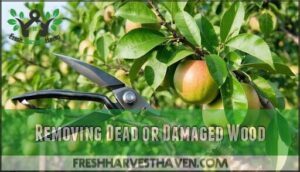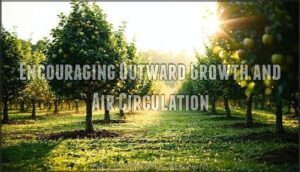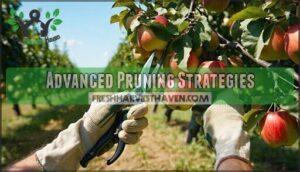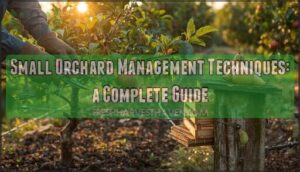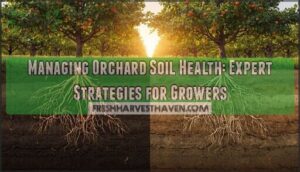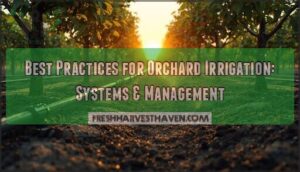This site is supported by our readers. We may earn a commission, at no cost to you, if you purchase through links.
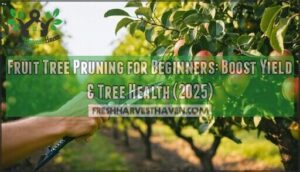
You’ll want to trim away dead, damaged, or crossing branches to let sunlight and air reach every leaf—think of it as giving your tree a haircut for better health and bigger harvests.
Use sharp bypass shears, clean your tools, and aim for a balanced, open shape.
Prune in late winter or early spring, before buds break.
Don’t worry if your first cut feels awkward; even seasoned gardeners started somewhere.
Curious about pruning tricks for apples or peaches? There’s more ahead.
Table Of Contents
- Key Takeaways
- Fruit Tree Pruning Basics
- Pruning Techniques for Beginners
- Top 5 Fruit Tree Pruning Essentials
- Advanced Pruning Strategies
- Frequently Asked Questions (FAQs)
- How to prune fruit trees for beginners?
- What are the 5 D’s of pruning?
- What is the 123 rule of pruning?
- How do you prune a fruit tree for beginners?
- What are the 3 C’s of pruning?
- What is the 1 3 rule for tree pruning?
- How often should I prune my fruit trees?
- Can I prune fruit trees in containers differently?
- What happens if I over-prune my tree?
- Should I seal pruning cuts with wound dressing?
- Conclusion
Key Takeaways
- You’ll boost fruit yield and tree health by pruning dead, diseased, and crossing branches each year.
- Always use sharp, clean tools and make cuts just above outward-facing buds to improve sunlight and airflow.
- Don’t remove more than one-third of the canopy in a single session—over-pruning stresses your tree and slows recovery.
- Skip wound dressings; let your tree heal naturally to avoid trapping moisture and inviting disease.
Fruit Tree Pruning Basics
Proper fruit tree pruning transforms stressed, unproductive trees into healthy giants that produce abundant, high-quality fruit year after year.
Prune smart—watch your fruit trees thrive and deliver bigger, better harvests season after season.
You’ll master the essential techniques that boost air circulation, direct sunlight where it’s needed most, and eliminate branches that compete for your tree’s energy, which will help your tree become a healthy giant.
Importance of Pruning for Tree Health
Proper pruning creates healthier fruit trees by preventing disease and improving structural stability.
You’ll reduce fungal infections and pest problems while strengthening your tree’s framework for better harvests.
- Disease Prevention: Removes infected branches before problems spread throughout the tree
- Air Circulation: Opens canopy to reduce moisture buildup that causes fungal issues
- Structural Integrity: Eliminates weak branches that could break under heavy fruit loads
Benefits of Pruning for Fruit Production
Fruit tree pruning transforms your orchard from ordinary to extraordinary.
You’ll see yield increase of up to 30% while dramatically improving fruit quality.
Proper cuts boost sunlight exposure, allowing energy to flow toward productive branches instead of wasteful growth.
Disease prevention becomes easier as improved airflow reduces fungal problems.
Your bountiful harvest starts with smart pruning for fruit production.
Understanding Tree Structure and Shape
Understanding tree structure starts with choosing between two main models: Central Leader and Open Center.
The Central Leader system maintains one dominant trunk with scaffold branches spreading outward, while Open Center creates a vase-like shape with multiple main branches.
For young fruit trees, focus on Branch Identification and Bud Orientation when establishing your Tree Architecture.
Select scaffold branches with 45-degree angles, ensuring they don’t crowd each other.
Understanding seasonal pruning practices is also key to fruit production.
This strategic tree shaping approach maximizes light penetration throughout the canopy, setting the foundation for productive fruit tree pruning that’ll pay dividends for years to come.
Tools and Equipment Needed for Pruning
Essential pruning tools include sharp bypass pruners for branches under ¾ inch, loppers for medium branches, and a pruning saw for larger cuts.
Protective gear like gloves and safety glasses prevents injuries. Ladder safety requires stable positioning and three-point contact.
Tool sharpening and pruner maintenance guarantee clean cuts that heal faster and reduce disease risk. Consider purchasing quality pruners for superior performance.
Tool sharpening and pruner maintenance guarantee clean cuts that heal faster and reduce disease risk.
Pruning Techniques for Beginners
Once you understand basic pruning principles, you’ll need to master specific techniques that work best for your situation and tree type.
The key is starting with simple cuts and building confidence as you learn to read your tree’s growth patterns and seasonal needs.
Pruning in Different Seasons
Timing makes all the difference when you prune your fruit trees. Understanding seasonal pruning helps you maximize both tree health and fruit production:
- Winter Pruning (dormant season) – Perfect for major shaping and dormant pruning of most fruit trees
- Summer Shaping – Light maintenance pruning and controlling vigorous Spring Growth
- Fall Cleanup – Avoid heavy cuts; focus on debris removal before dormancy
To have the right tools, consider specialized pruning equipment.
Timing Impacts everything from disease resistance to fruit yield in your beginner pruning guide.
Techniques for Different Types of Fruit Trees
Different fruit types need specific approaches for best results.
Apple Pruning and Pear Pruning use central leader systems, while Stone Fruit like peaches prefer open centers.
Citrus Pruning requires minimal cuts, and Dwarf Varieties need gentler handling.
| Tree Type | Structure | Key Technique |
|---|---|---|
| Apples | Central leader | Remove water sprouts annually |
| Peaches | Open center/vase | Maintain 3 main scaffolds |
| Cherries | Modified pyramid | Light thinning only |
| Citrus | Natural shape | Remove inward branches |
| Pears | Central leader | Angle cuts above buds |
Removing Dead or Damaged Wood
Before removing dead branches, grab clean pruning shears—dirty tools spread disease faster than gossip.
Follow the Three Ds Rule: cut diseased branches, damaged branches, and dead branches first. Make pruning cuts just above healthy buds, avoiding stubs that invite pests.
Disease Prevention starts with sharp, sanitized tools. Understanding seasonal pruning practices is key to ideal tree health.
Wound Sealing happens naturally when cuts heal properly, maintaining Structural Integrity. This Healing Process requires patience, but healthy trees reward you with better Pest Control naturally.
Encouraging Outward Growth and Air Circulation
Pruning your tree like a sculptor shapes marble—each cut directs future growth. Bud direction determines where new branches emerge, so always cut just above outward-facing buds to prevent inward growth that crowds the center.
Every snip is a brushstroke—shape your tree’s future by guiding each bud outward toward sunlight and space.
Strategic branch spacing and reduced canopy density maximize sunlight penetration throughout your tree.
- Remove inward-growing branches that compete for space and block airflow
- Thin crossing or rubbing branches to improve sunlight exposure and reduce disease pressure
- Maintain open center architecture for ideal fungal prevention through enhanced air circulation
Top 5 Fruit Tree Pruning Essentials
Getting the right tools makes pruning your fruit trees much easier and safer.
You’ll need quality pruning shears, a stable ladder, cleaning supplies for tool maintenance, and a good guide to reference proper techniques.
1. Fiskars Bypass Pruning Shears Clippers
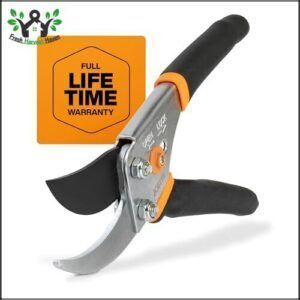
Your first pruning tool should be quality bypass pruning shears. Fiskars Bypass Pruning Shears deliver precision-ground steel blades with ergonomic design that reduces hand fatigue during extended use.
Their cutting capacity handles branches up to 5/8-inch diameter, perfect for fruit tree pruning basics. The low-friction coating prevents sap buildup, maintaining blade sharpness longer.
Alternative brands like Felco offer similar performance. Proper shear maintenance includes regular cleaning and blade sharpening.
These reliable tree pruning tools make pruning for beginners manageable and effective for maintaining healthy fruit trees.
2. HBTower Folding Step Ladder Stool
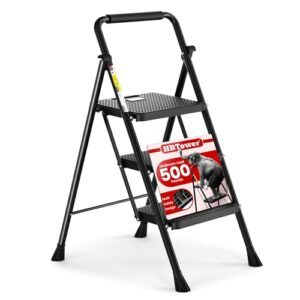
After choosing quality pruning shears, you’ll need reliable ladder safety to reach higher branches. The HBTower Folding Step Ladder Stool delivers exactly that for pruning fundamentals.
Its high-grade steel frame provides exceptional material durability and stool capacity up to 500 pounds. Wide, anti-slip steps and rubber handgrips guarantee your safety during tree pruning basics.
Understanding the tree’s fruiting wood type is vital for effective pruning. The clever folding mechanism makes ladder storage effortless, while its portability suits any fruit tree pruning basics session.
This beginners guide essential transforms challenging overhead cuts into manageable tasks for pruning for beginners.
3. Home Orchard Training and Pruning Guide
View On Amazon
Every successful home orchardist needs the Oregon State University’s Home Orchard Training and Pruning Guide in their toolkit.
This thorough fruit tree pruning guide transforms beginners into confident tree caretakers through detailed pruning techniques and tree training methods.
You’ll master orchard layout principles, proper tree spacing requirements, and essential soil preparation steps.
The guide covers complete fruit tree care, from establishing watering schedules to implementing effective pest control strategies.
What sets this resource apart? It bridges the gap between basic pruning for beginners guide concepts and advanced tree pruning techniques.
You’ll learn to shape young trees while preserving critical fruit buds, ensuring your orchard produces abundant harvests year after year.
Best For: Home gardeners seeking thorough knowledge to maximize fruit production through proper training and pruning methods.
4. Clorox Clean Up Bleach Refill

After mastering pruning basics, it’s time to keep your gear spotless. Grab the Clorox Clean Up Bleach Refill for disinfecting tools—because nobody wants sick trees!
Mix one part bleach to nine parts water for the right Bleach Dilution, then wipe or spray your pruners, loppers, and saws. Safe Handling is a must, so wear gloves and avoid splashes.
Check Surface Compatibility so you don’t ruin your favorite tools. Rinse off any Residue Removal to keep metal sharp and rust-free.
If bleach isn’t your thing, consider Alternative Disinfectants. Clean tools mean healthy trees, and a little bleach goes a long way in fruit tree care.
- Easy peace of mind
- No more worrying about spreading disease
- Quick and simple cleanup
- Tools last longer
- Your trees thank you
5. Amazon Basics Isopropyl Alcohol Antiseptic
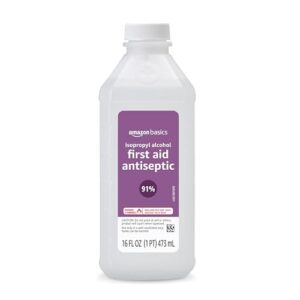
After cleaning up with bleach, grab Amazon Basics 91% Isopropyl Alcohol for quick tool sanitization.
With a high alcohol concentration, it knocks out bacteria and fungi fast—no waiting around while you prune fruit trees.
Wipe or spray your blades after each cut, especially when switching trees, to avoid spreading diseases.
It’s a staple for pruning basics, fruit tree training, and tree pruning for beginners, and unlike bleach, it won’t rust your gear.
Keep a spray bottle handy, and you’ll avoid spreading diseases, making it a practical choice for every pruning session.
This antiseptic also works for skin disinfection and wound care if you nick yourself, providing a reliable solution for accidents.
Advanced Pruning Strategies
You’re ready to tackle advanced pruning strategies, which help you shape your trees for maximum fruit quality and healthy growth.
With the right approach, you’ll avoid common mistakes and keep your orchard productive for years—no more mystery branches stealing the spotlight, ensuring maximum fruit quality.
Pruning for Specific Fruit Tree Varieties
Think of fruit tree pruning tips as learning a new dialect—each tree has its quirks. For Apple Pruning and Pear Pruning, go for a central leader, shaping trees like pyramids with sturdy trunks.
Pruning apple trees and pears works best in late winter. Peach Pruning and Cherry Pruning thrive with open vase shapes, letting sunlight flood the center.
Pruning peach trees and cherries usually happens in summer. Citrus Pruning needs selective thinning, keeping healthy interior limbs for sun protection.
Fruit tree pruning for beginners means knowing these differences. Proper pruning improves airflow, which helps in enhancing pest management through techniques found at links like enhancing pest management, and is key to healthy interior limbs, central leader, and overall tree sun protection.
Managing Tree Size and Shape
After choosing the right pruning plan for your fruit tree variety, it’s time to shape your orchard’s future. Managing tree size and shape is like sculpting—each cut directs growth and keeps your trees in check.
Dwarf Varieties make life easier, needing less frequent pruning, but don’t skip annual checkups. If you’re tight on space, Esperalier Training turns trees into living fences, handy for patios or small yards.
The central leader method builds strong trunks with well-spaced branches, while open center pruning creates a vase shape for maximum Sunlight Access. Want to keep things within reach? Height capping is your friend.
- Dwarf Varieties: less aggressive pruning frequency
- Espalier Training: space-saving, easy harvest
- Central leader method: strong, upright structure
- Open center pruning: boosts sunlight access
- Height capping: controls growth
Promoting Fruit Quality and Yield
Once you’ve got your tree’s size and shape sorted, focus on promoting fruit quality and yield.
Pruning fruit trees with smart techniques—like removing water sprouts and thinning branches—improves sunlight exposure and air circulation.
This branch balance lets your tree channel energy into fewer, better fruits, which results in tastier harvests, while pruning for fruit trees boosts overall fruit yield and consistency every season.
Common Mistakes to Avoid in Pruning
In the context of pruning mistakes, don’t let stub cuts or flush cuts trip you up—they slow healing and invite disease.
Dull tools make ragged wounds, so keep those blades sharp. Over Pruning is a classic error; taking off too much canopy means less photosynthesis and more tree stress.
Timing errors, like pruning in late summer or wet weather, can trigger vulnerable new growth and infections. Neglecting suckers leads to wasted energy.
Consider consulting an orchard pruning guide for specific tree needs. Stay strategic, avoid common mistakes, and your fruit trees will thank you with better health and bigger harvests.
Tips for Maintaining a Healthy and Productive Orchard
After dodging pruning pitfalls, focus on fruit tree maintenance year-round.
Keep your orchard thriving by monitoring soil health, adjusting fertilization, and meeting irrigation needs.
Disease prevention and pest control are just as essential as pruning for tree health and fruit quality.
Consider implementing espalier techniques for space-saving and decorative pruning.
Imagine this:
- Rich, crumbly soil underfoot
- Drip irrigation quietly soaking roots
- Healthy branches loaded with juicy fruit
Frequently Asked Questions (FAQs)
How to prune fruit trees for beginners?
Funny how branches always seem to crowd the center—just like socks in the dryer.
Snip dead or diseased limbs with sharp pruners, aiming above outward-facing buds.
Let sunlight and air dance through your tree’s canopy.
What are the 5 D’s of pruning?
You’ll want to remember the 5 D’s: remove branches that are Dead, Diseased, Damaged, Dying, or Deranged (growing weird directions).
This keeps your tree healthy, lets sunlight in, and prevents future problems.
What is the 123 rule of pruning?
Think of pruning like giving your tree a three-step haircut: first, remove dead wood; second, cut diseased branches; third, thin out crowded limbs.
You’ll keep your tree healthy, happy, and ready for a fruitful season!
How do you prune a fruit tree for beginners?
Start by removing dead, diseased, or crossing branches.
Always cut just above an outward-facing bud, using sharp tools.
Open up the center for sunlight and airflow. Don’t overdo it—prune about 20% each year.
What are the 3 C’s of pruning?
The 3 C’s of pruning are: Cut out dead wood, Clear crowded branches, and Clean up crossing limbs.
You’ll boost airflow, sunlight, and tree health.
It’s like giving your tree a fresh haircut for better growth!
What is the 1 3 rule for tree pruning?
The 1/3 rule means you shouldn’t remove more than one-third of a tree’s branches in a single pruning session.
Cutting too much at once stresses the tree, slows recovery, and can leave it vulnerable to disease.
How often should I prune my fruit trees?
Like giving your tree a yearly haircut, prune most fruit trees once a year during late winter or early spring.
Light trims in summer help shape growth, but avoid heavy pruning in fall to prevent winter damage.
Can I prune fruit trees in containers differently?
You’ll prune fruit trees in containers more often, shaping them for size and airflow.
Remove crowded branches, snip suckers, and keep the canopy open.
Container trees need extra attention since space is tight and growth can get wild.
What happens if I over-prune my tree?
If you give your tree a drastic haircut, it might sulk—expect fewer fruits, stunted growth, and sunburned bark.
You’ll risk stressing the roots, slow healing, and invite pests or disease.
Moderation keeps trees happy.
Should I seal pruning cuts with wound dressing?
You don’t need to seal pruning cuts with wound dressing—trees heal best on their own.
Dressings can trap moisture, inviting disease.
Let the tree’s natural defense kick in, and it’ll close up just fine, with its natural process unimpeded.
Conclusion
Did you know that regular pruning can boost fruit yield by up to 50%?
With fruit tree pruning for beginners, you’re not just shaping branches—you’re setting up your tree for years of healthy growth and bigger harvests.
Grab your sharp shears, clean your tools, and don’t stress about making that first cut.
Every snip improves air flow, sunlight, and fruit quality.
Stick with these basics, and soon your backyard orchard will be the envy of your neighbors, with bigger harvests.
- https://hort.extension.wisc.edu/articles/training-and-pruning-apple-trees/
- https://www.rhs.org.uk/fruit/apples/pruning-made-easy
- https://www.youtube.com/watch?v=_Ny_TJp6gVk
- https://www.gardeningknowhow.com/edible/fruits/cherry/cherry-tree-pruning.htm
- https://www.starkbros.com/growing-guide/how-to-grow/fruit-trees/cherry-trees/pruning

